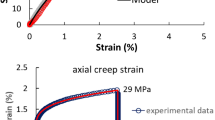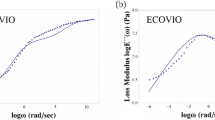Abstract
In recent decades, constitutive equations for polymers involving fractional calculus have been the object of ever increasing interest, due to their special suitability for describing self-similarity and memory effects, which are typical of viscoelastic behaviour in polymers. Thermodynamic validity of these equations can be ensured by obtaining them from analog models containing spring-pots with positive front factors. Failure of self-similarity in real polymers at short (local) and long (whole chain) scales has been addressed previously. In the past, interest in fractional differential descriptions of polymer viscoelasticity has been mainly concerned with linear viscoelasticity, despite the fact that in processing and end use conditions are largely in the non-linear range. In this paper, extension of fractional calculus models to the non-linear range of viscoelasticity is attempted, by accounting for stress activation of deformation and strain acceleration of annealing. Calculated stress-strain curves are compared with experimental results on an amorphous polymer (polycarbonate). The model adequately describes the general trends of yield and post-yield behaviour, but does not properly describe the gentle approach to yield observed experimentally.
Similar content being viewed by others
References
Oldham, K. B. and Spanier, J.,The Fractional Calculus, Academic Press, London, 1974.
Friedrich, Ch., Schiessel, H., and Blumen, A., ‘Constitutive behaviour modeling and fractional derivatives’, inAdvances in the Flow and Rheology of Non-Newtonian Fluids, D. A. Siginer, D. De Kee, and R. P. Chhabra (eds.), Elsevier, Amsterdam, 1999, pp. 429–466.
Caputo, M. and Mainardi, F., ‘A new dissipation model based on memory mechanism’,Pure and Applied Geophysics91, 1971, 134–147.
Torvik, P. J. and Bagley, R. L., ‘On the appearance of thefractional derivatives in the behavior of real materials’,Journal of Applied Mechanics51, 1984, 294–298.
Podlubny, I., Fractional Differential Equations, Academic Press, London, 1999.
Koeller, R. C., ‘Applications of fractional calculus to the theory of viscoelasticity’,Journal of Applied Mechanics51, 1984, 299–307.
Friedrich, Chr., ‘Relaxation and retardation functions of the Maxwell model with fractional derivatives’,Rheologica Acta30, 1991, 151–158.
Palade, L.-I. and DeSanto, J. A., ‘Dispersion equations which model high-frequency linear viscoelastic behavior as described by fractional derivative models’,International Journal of Non-Linear Mechanics36, 2001, 13–24.
Hern’ndez-Jiménez, A., Hern’ndez-Santiago, J.,Macias-Garci’, A., and S’nchez-Gonz’lez, J., ‘Relaxation modulus in PMMA and PTFE fitting by fractional Maxwell model’,Polymer Testing21, 2001, 325–331.
Wenchang, T., Wenxiao, P., and Mingyu, X., ‘A note on unsteady flows of a viscoelastic fluid with the fractional Maxwell model between two parallel plates’,International Journal of Non-Linear Mechanics38, 2003, 645–650.
Glöckle, W. G. and Nonnenmacher, T. F., ‘Fractional integral operators and Fox functions in the theory of viscoelasticity’,Macromolecules24,1991, 6426–6434.
Enelund, M. and Lesieutre, G. A., ‘Time domain modeling ofdamping using anelastic displacement fields and fractional calculus’,International Journal ofSolids and Structures36, 1999, 4447–4472.
Heymans, N., ‘Hierarchical models for viscoelasticity: Dynamic behaviour in the linear range’,Rheologica Acta35, 1996, 508–519.
Haupt, P., Lion, A., and Backhaus, E., ‘On the dynamic behaviour of polymers under finite strains: Constitutive modelling and identification of parameters’,International Journal of Solids and Structures37, 2000, 3633–3646.
Rossikhin, Yu. A. and Shitikova, M. V., ‘A new method for solving dynamic problems of fractional viscoelasticity’,InternationalJournal of Engineering Sciences39, 2001, 149–176.
Beris, A. N. and Edwards, B. J., ‘On the admissibility criteria for linear viscoelastic kernels’,Rheologica Acta32, 1993, 505–510.
Palade, L. I., Attané, P., Huilgol, R. R., and Mena, B., ‘Anomalous stability behaviour of a properly invariant constitutive equation which generalises fractional derivative models’,International Journal of Engineering Sciences37, 1999, 315–329.
Heymans, N., ‘Constitutive equations for polymer viscoelasticity derived from hierarchical models in cases of failure of time-temperature superposition’,Signal Processing83, 2003, 2345–2357.
Hellinckx, S., Heymans, N., and Bauwens, J.-C., ‘Analytical and fractal descriptions of non-linear mechanical behaviour of polymers’,Journal of Non-Crystalline Solids172–174, 1994, 1058–1061.
Heymans, N. and Kitagawa, M., ‘Modelling “unusual” behaviour after strain reversal with hierarchical fractional models’,Rheologica Acta43, 2004, 383–389.
Heymans, N. and Bauwens, J.-C., ‘Fractal rheological models and fractional differential equations for viscoelastic behavior’,Rheologica Acta33, 1994, 210–219.
Schiessel, H. and Blumen, A., ‘Mesoscopic pictures of the sol-gel transition: Ladder models and fractal networks’,Macromolecules28, 1995, 4013–4019.
Schiessel, H. and Blumen, A., ‘Fractal aspects in polymer science’,Fractals3, 1995, 483–490.
Schiessel, H., Metzler, A., Blumen, A., and Nonnenmacher, T. F., ‘Generalized viscoelastic models: Their fractional equations with solutions’,Journal of Physics A: Mathematical and General28, 1995, 6567–6584.
Glöckle, W. G. and Nonnenmacher, T. F., ‘Fox function representations of non-Debye relaxation processes’,Journal of Statistical Physics71, 1993, 741–757.
Bauwens-Crowet, C., Bauwens, J.-C., and Homès, G., ‘Tensile yield stress behavior of glassy polymers’,Journal of Polymer Science: Part A-27, 1969, 735–742.
Bauwens-Crowet, C., Bauwens, J.-C., and Homès, G., ‘The temperature dependence of yield of polycarbonate in uniaxial compression and tensile tests’,Journal of Materials Science7, 1972, 176–183.
Bauwens-Crowet, C., ‘Long-term physical ageing of polycarbonate at room temperature: Dynamic mechanical measurements’,Journal of Materials Science34, 1999, 1701–1709.
Othmezouri-Decerf, J., ‘Investigation of the low temperature ageing kinetics of glassy polycarbonate by mechanical damping spectroscopy’,Journal of Materials Science34, 1999, 2351–2359.
Bauwens, J.-C., ‘Relation between the compression yield stress and the mechanical loss peak of bisphenol-A-polycarbonate in the β transition range’Journal of Materials Science7, 1972, 577–584.
Heymans, N. and van Rossum, S., ‘FTIR investigation of structural modifications during low-temperature ageing of polycarbonate’,Journal of Materials Science37, 2002, 4273–4277.
Author information
Authors and Affiliations
Corresponding author
Rights and permissions
About this article
Cite this article
Heymans, N. Fractional Calculus Description of Non-Linear Viscoelastic Behaviour of Polymers. Nonlinear Dyn 38, 221–231 (2004). https://doi.org/10.1007/s11071-004-3757-5
Received:
Accepted:
Issue Date:
DOI: https://doi.org/10.1007/s11071-004-3757-5




